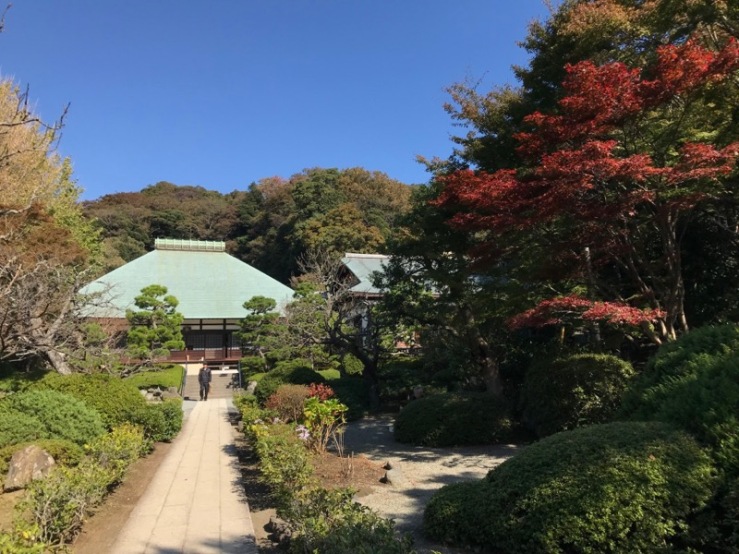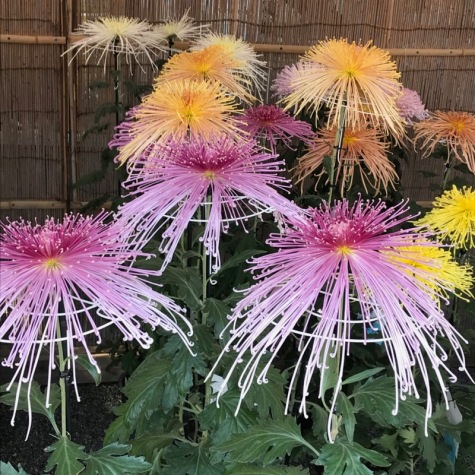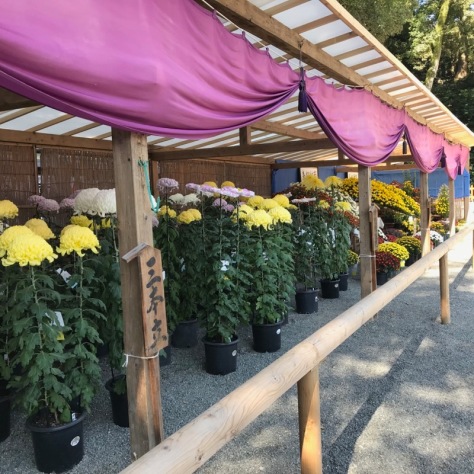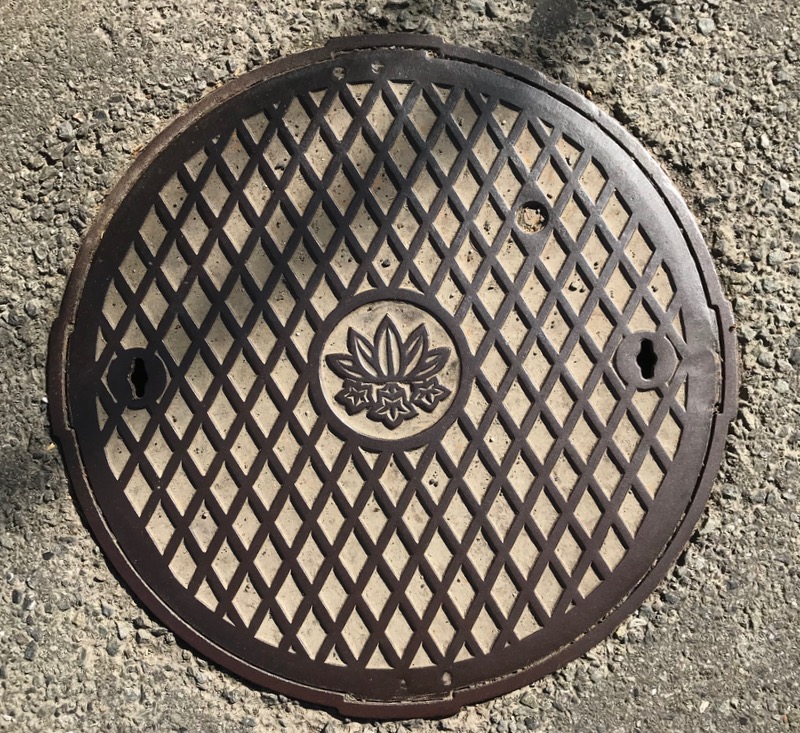This is post #4 of our Tokyo-Seoul trip, for the first part of Tuesday, November 7, 2017.

Just to remind myself: I am in a different country. Good morning, Tokyo. Today is Kamakura Day!

We squared away our travel on Hyperdia, got ourselves ready and headed to City Bakery to get our breakfast to go. 
From the City Bakery, we had a wild walk through the tunnels of the Shimbashi Station through throngs of commuters–snaking up and down and around, 10 and 12 deep in lines coming down the stairs, just waiting to get down on the platform. Tokyo rush hour at its finest. I would have stopped to take a photo, but we were rushing to make the train for Kurihama (Kamakura).

It was a crush, and I admired this fellow’s set-up, of head-on-pole-for-a-rest. But the farther out into the country we headed, the more room there was on the trains (the journey to Kamakura was about 60 minutes). A young family with two boys — one more gregarious (read: out of control) than the other — were also in our car, and they spoke English.
We struck up a conversation and found out the young mother had grown up in Japan, but now lived in New York City on Staten Island; the children were being “World Schooled.” I later wondered to Dave if that means that the parents just wanted to travel the world during school time, and not be tied down. I had to wonder what the boys would remember. The young mother shared with us their itinerary (below), which was thoughtful. We must have looked more lost than we felt. The train came to a stop and she told us that this was the station, and we should get off.

We stopped at the Visitor’s Center and after buying our two bus passes, we looked for a place to eat our breakfast, which of course, this being Japan, there are no easy places to eat unless you are in a restaurant or in your home.

So, dorky tourists that we are, we sat down on the bus station bench and ate our breakfast (the green letter “B” on the map below). Then we ambled back to the train station and caught the small tram out to our first stop.


The tram was really crowded, but at the first stop many left. We continued on to Hokikuji, the “bamboo forest” temple.

The tram stopped across the street, and the entrances were well-marked.

This is what we saw when entering the temple area.

To our right were discreet signs blocking entrance.

The building directly in front of us, also had elegant structures, restricting our entrance.

But the more faithful paused and said their prayers. Usually they let you get close enough to throw the money into the box with the slotted top, but even that wasn’t available. We proceeded further to the left, to an open window. I handed them my book; they handed me a tag with a number on it; there was also a charge to get my Shuin-cho (folded signature book) signed (300 Yen). We found out that they charged entry for this temple (200 Yen, about $1.80/person); we paid up and entered.

Even their pathways show great attention to detail.

We enter the bamboo forest. It’s smaller than we thought (when they say “forest,” we Americans imagine something along the order of the Amazon), but quiet and beautiful. This species of bamboo, “moso,” is the biggest kind of bamboo reaching heights of 92 feet; it is originally from China.



There are many small shrines along the pathway, which led up a small rise, near some “yagura,” which is a cave to accommodate tombs, but we really couldn’t see into it.

The grounds are beautiful, with a koi pond, and beautiful trees, which were being trimmed that day:



We saw three other school girls along the short path through the forest, and we kept dodging them. Finally I offered to take their photo (not the group above), and they offered to take ours.

We try to get a “Christmas Card” photo on every trip, and were happy to have a candidate so early in our travels; we did end up using this one.

The short walk over, we collect my book, and head out, landing ourselves in the accompanying graveyard.


This being Japan, and this being a long day of being on the go, when I saw the sign for restroom, I took advantage of it.

Okay, not this one. I found a Westernized toilet in one of the three stalls, and was also happy to notice that they provided toilet paper. As I near the toilet, the sound of running water starts up from a speaker next to the toilet. Whether it’s to encourage quick use of the facilities, or disguise any sounds, I don’t know.
Street scenes: manhole covers, and a Hello Kitty blanket hanging from the balcony. I try not to look around too much because in all the tourist brochures we have strict instructions:
- Please visit shrines and temples in a calm and quiet manner.
- On the streets in town, please be careful not to bother the residents.
- Please mind the people around you when eating and drinking on the streets.
- And my favorite: Please take home your own garbage, do not leave them.
We did carry around a “garbage bag” into which we put our trash, as public trash cans are few and far in-between.


We walked from Hokokuji (Bamboo temple) across the street to the Jomyoji Temple, mainly because it was…right across the street. Again, we leave our book at the front little building, and walk around to go in. A group of tourists was just coming out and one of them, a man, called out, “Don’t go there!” After ten minutes, we’d seen just about everything, so he was mostly right.



I liked their water spout systems–much prettier than a gutter snaking down the wall.

While the temples don’t really let you in, some visitors take their shoes off at the top step, some don’t. All bring their hands together and bow. They were serving tea inside one of these buildings, something we guessed was part of a tourist tour, so we crept about.

A funeral had just ended, and we hung back to see the priest, and the patrons (below) climb up the hill into the cemetary.


Leaving Jomyoji. The place where we left the book is to the right at the bottom of the stairs (where the young man is headed). Price for this one: 100 Yen (a little less than a dollar), but the book was 300 Yen (a little less than $3).
Walking down the street toward the bus stop, we heard some sounds coming from over the wall. Looking over, we saw a man in waders with a week-whacker, trimming up the stream’s vegetation. Vaguely hungry, we entertained the idea of eating a “garden of herbs, wild flowers and vegetables,” but settled for buying a bottled drink at the vending machine next to the bus stop.
The bus took the corner and dropped us about a block away from the entrance. We swam upstream against a group of school girls, all dressed in matching uniforms. By the end of the day, we could identify whose parents spent the most on their schooling, with the top of the ranking being the complete matching uniforms (like the ones above), moving downward to matching shirts only, and from there on down to matching kerchiefs around their necks, ending up with matching color of hats. My children would have been in the latter category, for sure.

Dave got a great shot of the scramble crosswalks in front of the torii gate, the large red structure marking the transition from the mundane to the sacred.

A good map of the grounds of Tsurugaoka Hachimangu Shrine. After walking through the torii gate, there is a long open walkway with booths selling items: desserts, cotton candy, ice cream, loose bins of candy (fill your own bag), and pineapples.



Dave patiently waits for me while I purchase some stars; happily we seem to be over our “first-day adjustment phase.”

After the open yard with the booths, we approach this series of buildings: the temizuya (water purification basin), the maiden (lower worship hall), and the Shrine Office.

Wikipedia gives some details about the purification font:
“A chōzuya or temizuya (手水舎) is a Shinto water ablution pavilion for a ceremonial purification rite known as temizu. Water-filled basins, called chōzubachi, are used by worshippers for washing their left hands, right hands, mouth and finally the handle of the water ladle to purify themselves before approaching the main Shinto shrine or shaden (社殿). This symbolic purification is normal before worship and all manned shrines have this facility, as well as many Buddhist temples and some new religious houses of worship. The temizuya is usually an open area where clear water fills one or various stone basins. Wooden dippers are usually available to worshippers. Originally, this purification was done at a spring, stream or seashore and this is still considered the ideal. Worshippers at the Inner Shrine at Ise still use this traditional way of ablution.”
I’m in love with the vermillion-painted buildings, with shiny brass fittings and decorative painting.



In this view, the shide, or paper streamers, hang down from the rice rope around the top.




Dave sends me over to where I can get my book signed (to the left of the tented area), and wanders around while I stand in the long line. He comes back and holds my place while I buy an ema for this place. They have two colors of wooden gingko leaves; I buy the green, but will forever wonder why I didn’t buy the gold…or both. I rejoin him in line in time for the monk to sign my book.

And then I shyly put forward my ema for him to write on, which kind of blows his mind, as it’s totally against what is supposed to happen. He explains, kindly, and in Japanese that I’m to write my own prayer, and I, kindly, and in English, ask him to write the symbol of the temple on the ema. After a bit of back and forth, and me offering to pay again, he does, but I’m sure he thinks I’m a bit nuts.



Dave had gone over to the flower show on the side of the temple grounds.

These were amazing–the large sprays overflowing the table are all grown from one plant. They also had displays of different types of flowers:




And up the steps we go to the main shrine, or Hongu.



It’s huge, ornate, and again, no photos of the interior. This present building was erected in 1828, according to the brochure I carry around.




We already did this dance at Asakusa.

There are multiple of small red buildings on this site; I stop trying to figure them out, or why they are important, and just enjoy the visuals.

To the left of the Hongu are these toriis; we head up to the Maruyama-Inarisha Shrine, which is dedicated to the deity of harvest.




Is it wrong to covet ema? If I could have figure out how to buy one of these in a torii shape, I would have.

We head down the backway, onto a small street that brings us back around to the main area. We head to the bus stop, sort of wondering about lunch, or something, as we were ready for a break, and were hot and a bit tired.

While we were waiting at the bus stop, a man comes out of the rickshaw shop and says “It’s only a five-minute walk to the station.” We thank him, and continue waiting. Then another random man comes up to us and says “A couple of minutes walk is all,” and gestures vaguely down the street towards the station. We decide to walk.

And after five minutes walking facing the sun, we decided we were played, that the helpful locals could safely be categorized as bending the truth. It was a 20 minute walk, but we made it.
Next up: Kamakura, Part 2.










I think you must have worn all the tread off your shoes on this day! You really got around and saw some beautiful sites. I was feeling for you when I saw the picture of the squat toilet, and glad you found another “western-style” one. My daughter says the Japanese are very private about body noises, hence the running water sound to mask anything inappropriate.